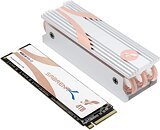- Joined
- Aug 19, 2017
- Messages
- 3,194 (1.11/day)
Sabrent, an American hardware manufacturer, has recently started breaking records with the world's first everything. Starting from the recent 8 TB PCIe 3.0 NVMe SSD that comes in M.2 format, Sabrent doesn't plan to stop there. Thanks to the keen eyes of folks over at TweakTown, we have found out that Sabrent has prepared to launch the new Rocket Q4 SSD which is a PCIe 4.0 NVMe monster. Coming in the capacity of 4 TB, the company has built the world's first 4 TB PCIe 4.0 NVMe SSD.
When it comes to specifications of the SSD, it can reach some quite impressive speeds. When writing, it reaches 3500 MB/sec (3.5 GB/sec), and in the reading, it can reach up to 4900 MB/sec (4.9 GB/sec). Now imagine putting two of these in RAID 0. Nonetheless, we don't know what controller the company is using for this model. The NAND chips used are QLC based. But you are now wondering about the price of it. The purchase of this SSD will set you back $770 with a heatsink or $750 without one. You can purchase the SSD here.

View at TechPowerUp Main Site
When it comes to specifications of the SSD, it can reach some quite impressive speeds. When writing, it reaches 3500 MB/sec (3.5 GB/sec), and in the reading, it can reach up to 4900 MB/sec (4.9 GB/sec). Now imagine putting two of these in RAID 0. Nonetheless, we don't know what controller the company is using for this model. The NAND chips used are QLC based. But you are now wondering about the price of it. The purchase of this SSD will set you back $770 with a heatsink or $750 without one. You can purchase the SSD here.

View at TechPowerUp Main Site









